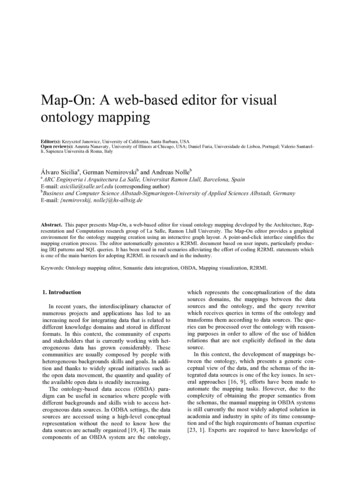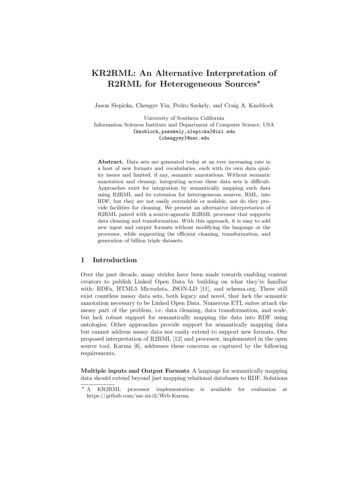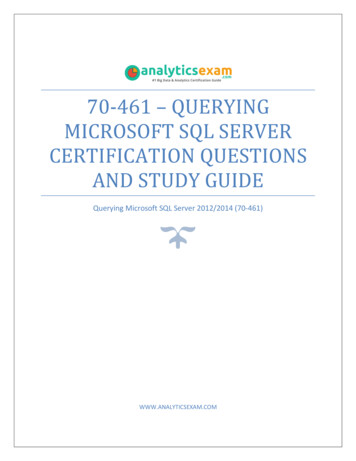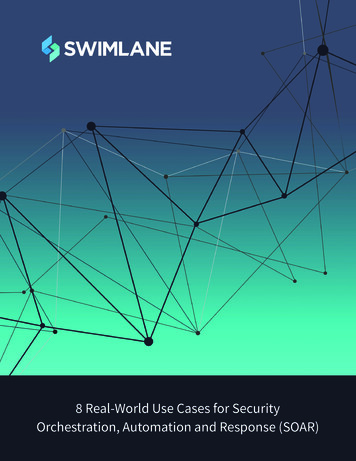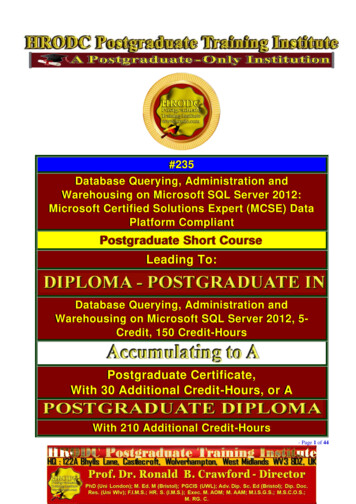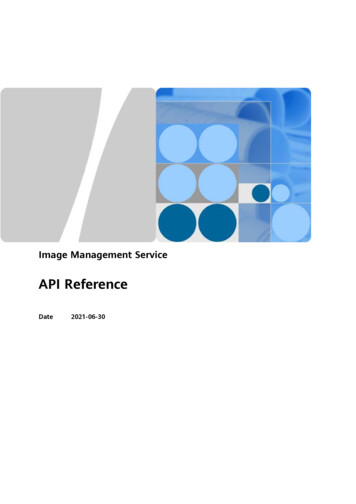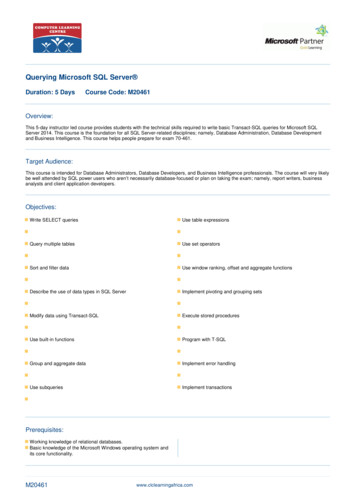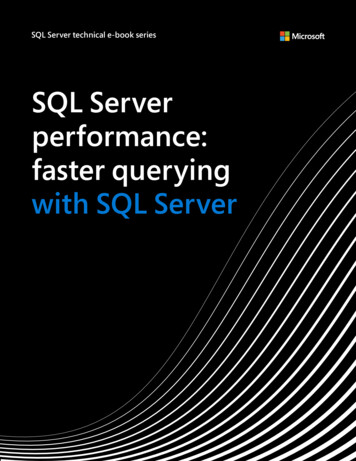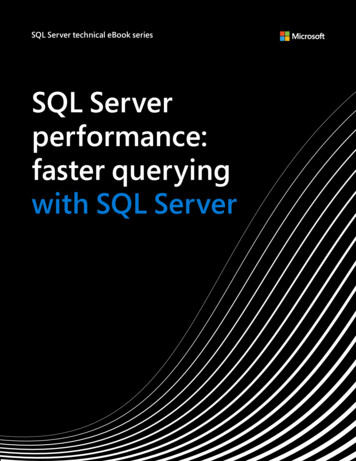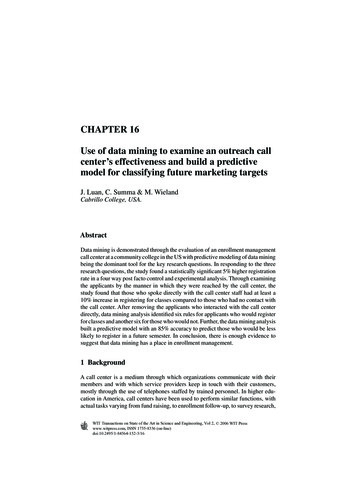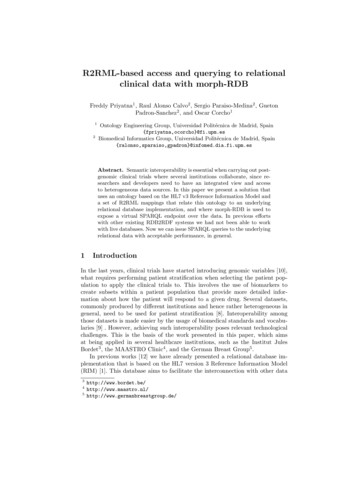
Transcription
R2RML-based access and querying to relationalclinical data with morph-RDBFreddy Priyatna1 , Raul Alonso Calvo2 , Sergio Paraiso-Medina2 , GuetonPadron-Sanchez2 , and Oscar Corcho112Ontology Engineering Group, Universidad Politécnica de Madrid, Spain{fpriyatna,ocorcho}@fi.upm.esBiomedical Informatics Group, Universidad Politécnica de Madrid, .esAbstract. Semantic interoperability is essential when carrying out postgenomic clinical trials where several institutions collaborate, since researchers and developers need to have an integrated view and accessto heterogeneous data sources. In this paper we present a solution thatuses an ontology based on the HL7 v3 Reference Information Model anda set of R2RML mappings that relate this ontology to an underlyingrelational database implementation, and where morph-RDB is used toexpose a virtual SPARQL endpoint over the data. In previous effortswith other existing RDB2RDF systems we had not been able to workwith live databases. Now we can issue SPARQL queries to the underlyingrelational data with acceptable performance, in general.1IntroductionIn the last years, clinical trials have started introducing genomic variables [10],what requires performing patient stratification when selecting the patient population to apply the clinical trials to. This involves the use of biomarkers tocreate subsets within a patient population that provide more detailed information about how the patient will respond to a given drug. Several datasets,commonly produced by different institutions and hence rather heterogeneous ingeneral, need to be used for patient stratification [8]. Interoperability amongthose datasets is made easier by the usage of biomedical standards and vocabularies [9] . However, achieving such interoperability poses relevant technologicalchallenges. This is the basis of the work presented in this paper, which aimsat being applied in several healthcare institutions, such as the Institut JulesBordet3 , the MAASTRO Clinic4 , and the German Breast Group5 .In previous works [12] we have already presented a relational database implementation that is based on the HL7 version 3 Reference Information Model(RIM) [1]. This database aims to facilitate the interconnection with other http://www.germanbreastgroup.de/
2R2RML-based access to relational clinical data with morph-RDBsources where medical ontologies are also being used, and has already been usedfor providing some form of interoperability among real data sources [12] fromthe aforementioned institutions. Currently we are working in providing ontologybased support to data access, so as to facilitate such integration and allow incorporating other datasets more easily. This is the reason why we are lookinginto using a Relational Database to RDF (RDB2RDF) solution. We also provide a SPARQL endpoint so that users are relieved from knowing the underlyingschema of the implemented database.RDB2RDF mappings are used to expose data from relational databases asRDF datasets. Two major types of data access mechanisms are normally provided by RDB2RDF tools: i) data translation (a specific case of ETL - Extract,Transform, Load -), where data are materialized into RDF datasets and stored ina triple store (e.g., Virtuoso), which provides a SPARQL endpoint; and ii) querytranslation, where SPARQL queries are directly translated into SQL according to the specified RDB2RDF mappings, and evaluated against the relationaldatabase, and where results are translated back using the mappings to conformwith the SPARQL query. In our case, we are interested in using RDB2RDF mappings to make the data stored in our SQL implementation available according toan ontology that reflects the HL7 version 3 RIM. Furthermore, we have a strongrequirement to use a query translation approach, given the importance of havingfresh results, what cannot be always ensured in the data translation approach.Our first attempt [11] at applying RDB2RDF-based query translation waswith D2R server and mappings [2]. This approach was not applicable since theevaluation of the SQL queries resulting from query translation was not efficientenough. Moreover, in some cases, queries could not be executed by the databasemanagement system (e.g., their length was excessive). This has been alreadyhinted in [7] that describes the experience of using RDB2RDF tools in the domain of astronomy. The conclusion there was that RDB2RDF tools were notfeasible to be used in such a context, and this conclusion was consistent withour first attempt.Later, we started using morph-RDB [13] with R2RML mappings [5] for thispurpose. We have obtained better results that make this approach applicable inour context. In this paper we describe our experience, which shows that it ispossible to use efficient RDB2RDF tools in the medical domain.This paper is organized as follows. Section 2 discusses the necessary background such as our current model for storing medical data, the HL7 RIM ontology, the R2RML mapping language, and our query translation engine morphRDB. We discuss some optimization techniques in Section 3. In Section 4 wediscuss the set of queries that we use for the evaluation. Finally in Section 5we provide some conclusions and describe some of our future work in this area,including our deployment plans in aforementioned healthcare institutions.
R2RML-based access to relational clinical data with morph-RDB23Background: HL7, R2RML, and morph-RDBIn this section we will review the main foundations of the work that we presentin the paper, namely HL7 and the HL7 RIM, the R2RML language, and morphRDB.2.1HL7 RIMRecent years have witnessed a huge increase of biomedical databases [6]. Thislarger availability opens up new opportunities, while setting some new importantchallenges, especially in what respects to their integration, which is crucial toobtain a proportional increment of knowledge on the biomedical area.Among the many Detailed Clinical Models that have been reviewed for theintegration of biomedical datasets [4], the HL7 v3 is one of the most relevant. TheHL7 v3 standard defines the RIM at its core, this definition consists of a UMLclass diagram (it does not define a data structure or a database model). Besides,issues such as the management of data types are not trivially translatable intoa database model. As a consequence, we have defined in the past a relationalmodel for it, as described in [12].The HL7 RIM backbone contains three main classes (Act, Role and Entity),which are linked together using three association classes (Act-Relationship,Participation and RoleLink). The core of the HL7 RIM is the Act class.An Act is defined as “a record of an event that has happened or may happen”.Any healthcare situation and all information concerning it should be describableusing the RIM by including the type of act (what happens), the actor whoperforms the deed and the objects or subjects Entity that the act affects toRole. Some additional information may be provided to indicate location (where),time (when), manner (how), together with reasons (why) or motives (what for).Act and Entity classes have some specializations that add some attributes, suchas Observation (a subclass of Act), or Person (a subclass of Entity).This standard is able to represent all kinds of healthcare situations and anykind of information associated with it. Based on this idea, we have defined asubset of the HL7 RIM schema, where we implement the classes and attributesthat are necessary to represent the scenario for sharing clinical data of breastcancer clinical trials:– Act, with the subclasses Observation, Procedure, SubstanceAdministration,and Exposure.– Role.– Entity, with the sub-classes LivingSubject, Person, and Device.– The classes; i)ActProcedureApproachSiteCode, ii) ActMethodCode,iii) ActTargetSiteCode, iv) ActObservationInterpretationCode, and v)ActObservationValues related to Act.Besides, attribute data types are rather complex on the RIM, so they arechanged according to the mentioned scenario, following HL7 recommendations.
4R2RML-based access to relational clinical data with morph-RDBTherefore some attributes were simplified in the relational model compared tothose defined by HL7 v3 standard. To improve a better performance and knowledge on the HL7 RIM schema, it is defined a set of views. These views cover theaccess retrieval requirements for the clinical scenario. Therefore it is implementeda different view for obtaining patient data due to its provenance (Observation,Procedure, SubstanceAdministration, and Exposure).Therefore, the defined HL7 RIM based CDM above fulfills the requirementsneeded by breast cancer in clinical trials scenario. Furthermore, we have createdan ontology that reflects the HL7RIM model6 , available for others to reuse.2.2R2RMLR2RML [5] is a W3C recommendation for the definition of a mapping languagefrom relational databases to RDF. An R2RML mapping document consists of aset of Triples Maps rr:TriplesMap, used to specify the rules to generate RDFtriples from database rows/values. A TriplesMap consists of:– A logical table rr:LogicalTable that is either a base table or SQL view,used to provide the rows to be mapped as RDF triples.– A subject map rr:SubjectMap that is used to specify the rules to generatethe subject component of RDF triples.– A set of predicate object maps rr:PredicateObjectMap that is composed bya set of predicate maps rr:PredicateMap and object maps rr:ObjectMap(to generate the predicate and object components of RDF triples, respectively). If a join with another triples map is needed, a reference object maprr:RefObjectMap can be used. The other triples map to be joined is specifiedin rr:parentTriplesMap and the join condition is specified via rr:JoinSubject maps, predicate maps, and object maps are term maps, which areused to specify rules to generate the corresponding RDF triples element, andthose rules can be specified as a constant rr:constant, a database columnrr:column, or a template rr:template.2.3morph-RDBmorph-RDB, which belongs to the morph suite7 , i.e., receives as an input theconnection details to a relational database, an R2RML mapping document anda SPARQL query and translates the query into SQL according to the R2RMLmapping, evaluates it into the underlying relational database and translatesback those results into the format required as a result of the SPARQL queryevaluation. The query translator component in morph-RDB implements the algorithm described in [13], which extends previous work in [3] that defines a setof mappings and functions in order to translate SPARQL queries posed intoRDB-backed triples stores into SQL queries, and prove that the correctness es/334-morph
R2RML-based access to relational clinical data with morph-RDB5the query translation using the notion semantic-preserving, in other words, theresults of the SPARQL and SQL return the same answers. We extend their workby relating those mappings and functions with the R2RML mapping elements.Example 1. Consider the following table v person(patientId, patientName,gender, actId) that stores the information about patients. This table is mappedto class Patient with the attribute patientId as the identifier (together withbase URI for class Patient) of the instances. Attributes patientId and patientNameare mapped to ontology properties hasID and hasName, respectively. Now let’sadd another table v observation(actId, title, code) that describes observations. This table is mapped to class Observation with actId as the identifier of the instances, and the attribute title is mapped to property hasTitle.patientId and actId are primary keys of the tables v person and v observation,respectively. Furthermore, the actId of table v person is a foreign key thatrefers to the column actId of table v observation, and this relation is mappedto property hasObservation.The instances of the tables can be seen in Figure 1.Fig. 1. Tables Person and ObservationNow consider the following graph pattern.{ ?p :hasID ?pID ; :hasName ?pName . }The SQL query translated by morph-RDB will be:SELECT T1.patientId, T2.patientNameFROM T1 INNER JOIN T2 ON T1.patientId T2.patientId;where T1 (SELECT patientId FROM v person WHERE patientId IS NOT NULL)and T2 (SELECT patientId, patientName FROM v person WHERE patientIdIS NOT NULL AND patientName IS NOT NULL) are the results of translatingthe first and second triple patterns, respectively.3Query Optimizations.The query translation technique presented above do not necessarily generateoptimal SQL queries. Based on the set of SPARQL queries we have evaluated,we have observed that several patterns occur frequently. Hence we describe optimization techniques that can be applied in order to generate more efficientqueries.
6R2RML-based access to relational clinical data with morph-RDB– Self-join elimination. A set of triple patterns connected by the AND operator and sharing the same subject occur frequently. We call this patternSubject Triple Group (STG). Using a naı̈ve query translation, each triplepattern corresponds to an INNER join in the generated SQL query. We haveextended our query translation technique so that in addition to handlingtriple patterns, each of the mappings/functions is also able to handle STG.Example 2. Consider again the SPARQL query in Example 1. With self-joinelimination, now the result of translating that query is:SELECT T1.patientId, T1.patientName FROM v personWHERE patientId IS NOT NULL AND patientName IS NOT NULL;– Left-outer join to inner join. Another pattern is a Subject Triple Groupwith Optional (OSTG), that is an OPTIONAL pattern that consists only onetriple pattern, preceded by an STG pattern or a triple pattern. Because theOPTIONAL keyword corresponds to a left outer join, naively translating thispattern produces one left-outer join for each OPTIONAL pattern. We extendour query translation technique, so that the optimized query translationgenerates an inner join, cheaper to evaluate than left-outer join, by removing the conditional expression IS NOT NULL corresponding to the functiongenCondSQL of the triple pattern in the OPTIONAL pattern.Example 3. Consider the following pattern:{ ?p :hasID :pid . OPTIONAL { ?p :hasName ?pname . } }Without left-outer join elimination, the result of translating this query is:SELECT T1.patientId, T2.patientName FROM(SELECT patientId FROM v personWHERE patientId IS NOT NULL) T1 LEFT OUTER JOIN(SELECT patientId, patientName FROM v personWHERE patientId IS NOT NULL AND patientName IS NOT NULL) T2ON T1.patientId T2.patientId;By changing the type of join from left-outer to inner, and removing the conditional expression name IS NOT NULL, and applying the self-join elimination(O1), the optimized query generated becomes:SELECT T2.patientId, T2.patientName FROM v person T2;– Phantom triple pattern introduction.Example 4. Consider the following pattern, which is neither an STG patternnor an OSTG, thus, none of the aforementioned optimizations can be applied.{ ?p :hasObservation ?o .OPTIONAL { ?s :hasTitle ?t . } }In order to exploit those optimisations we have presented so far, this queryhas to be transformed into another query whose resulting query translationcan be optimised. To do that, we use the fact that for every IRI x, the fact(x a rdf:Resource) holds, so that we can safely add this triple pattern to thequery without changing its semantics. We call such triple pattern a phantomtriple pattern. The result of adding the phantom triple pattern is:
R2RML-based access to relational clinical data with morph-RDB7{ ?p :hasObservation ?s . ?s rdf:type rdf:Resource .OPTIONAL { ?s :hasTitle ?t . } }Now with the new pattern that emerged, the optimization for OSTG patterncan be applied.4EvaluationWe have collected a total of 45 SPARQL queries that are used in the patientrecruitment and cohort selection scenario for breast cancer clinical trials. Thecomplete list of queries and their natural language descriptions are available athttp://bit.ly/1LecA7L. From this query list, we asked our domain experts togroup the queries into a set of five groups that are representative of the wholeset, and they are shown in Table 1.Representative Similar queriesTPqueryQ011, 2, 5, 15, 19, 37, 41, 424Q103, 10, 11, 4025Q144, 6, 9, 14, 16, 17, 18, 19, 21, 35, 38, 39, 4315Q3422, 23, 24, 25, 26, 27, 28, 29, 30, 31, 32, 33, 34, 44 6Q457, 8, 12, 13, 20, 36, 4514subjects OPT FILTER2963512151404 (IN)2 (IN, arithmetic)1 (IN)2 (IN)Table 1. Grouping of all queries according to the use case queriesThe query characteristics of each the representative query are as follows:– Demographics query (Q01). This query retrieves the information of allpatients. It contains 4 triple patterns, 2 unique subjects, 1 triple patternthat is inside an OPTIONAL block, and 1 FILTER pattern.– Substance administration query (Q10). This query retrieves the information of patients who were administered diphosphonate, including theinformation associated with the target site, the method used, and the approach site, if it exists. It consists of 35 triples patterns with 9 unique subjects. Most of the triple patterns are inside nested OPTIONAL blocks. Thereare 21 OPTIONAL blocks in this query, some of which are nested under another OPTIONAL block. A FILTER pattern is used to filter results basedon a certain condition.– Laboratory results query (Q14). This query retrieves the informationof patients who suffer anemia and whose body mass index is less than orequal to 30. It contains 15 triple patterns, with six unique subjects and5 OPTIONAL patterns. Furthermore, some of the OPTIONAL blocks arenested inside a parent OPTIONAL block. This query also contains two FILTER patterns to filter results for particular code values and to perform somearithmetic calculations.– Procedure query (Q34). This query retrieves the information of all patients who were administered chemotherapy. It consists of 6 triple patternswith one of them located inside an OPTIONAL pattern, and one FILTERpattern. There are 3 unique subjects in this query.
8R2RML-based access to relational clinical data with morph-RDB– Observation query (Q45). This query retrieves the information of patientswho have been detected a category T2 breast tumor. It consists of 14 triplepatterns and 5 unique subjects. There are 4 OPTIONAL patterns, one ofthem nested, and 2 FILTER patterns.The machine used in our evaluation has the following specifications: CPUIntel(R) Xeon(R) CPU E5-2650 0 @ 2.00GHz, 8 GB of RAM, 750 GB HDD withUbuntu Server 12.04 and MySQL Server 5.5. The dataset contains informationof 3 months of historical clinical data, with 4674 patients and 65056 acts, amongmany other tables. The total size of the database is 105 MB. This database willbe growing in the future, as more data is added as a result of the data integrationprocesses carried out in the context of the projects where the database is beinggenerated.We were interested in comparing morph-RDB with another well-establishedRDB2RDF engine, such as D2R, considering the total time required for theexecution of the SPARQL queries. That is, we include in our calculation thetime required to initialize the engine, the time needed for SPARQL-to-SQL querytranslation, the time needed to evaluate the SQL queries, and the time neededto translate back the result from the database using the mappings into the resultexpected by the SPARQL queries. Figure 2 provides details for the five selectedqueries, which are also similar to the results obtained for the other queries inour query set. We can easily see that in most cases our total execution time ismuch lower than the one required for D2R Server. In some cases (queries Q14and Q45) D2R Server was not able to produce results in less than five minutes.The results for the rest of the queries are available at http://bit.ly/1LecA7L.We were also interested in how the SQL queries that result from the queryrewriting approach perform in comparison to the SQL queries that would havebeen natively created by a SQL expert. For this reason, we asked a domainexpert with good knowledge of the HL7 RIM relational database to constructSQL queries that were semantically equivalent to the corresponding SPARQLqueries. In other words, without taking into account the mapping elements, suchas template or URI generation, the SPARQL and SQL queries should return thesame answer.Fig. 2. Running time for our selected queries on morph-RDB and D2R (in seconds)We evaluated each query 5 times in cold and warm modes. In the cold mode,we restart the server and empty the cache before we evaluate the next query. In
R2RML-based access to relational clinical data with morph-RDB9the warm mode, we skip these steps and execute the queries directly one afterthe another. We measure the averages of query execution time and normalize thequery evaluation time to the native query evaluation time. As an additional note,we can only do this type of evaluation using morph-RDB and native queries, asD2R Server produces multiple SQL queries in many cases and performs joins inmemory, what makes it not comparable with the native or morph-RDB queries.Fig. 3. Query evaluation time in warm and cold modesThe results from both evaluation modes show a similar trend. Furthermore,we observed that in the warm mode, the database server doesn’t lose its capability of reusing previous results of the query cache. This is reflected by the fact thatonly the first run of the query takes more time to complete, while subsequentqueries can be evaluated with only a fraction of that time. Some of those queriesproduced by morph-RDB can be evaluated in a reasonable time. For example,the resulting query translation of query Q01 can be evaluated in a similar timeas the native query Q01. Furthermore, the resulting query translation Q34 canbe evaluated in less time than its corresponding native queries, which can be anindicator that there might be still room for improving the corresponding nativequery. Some other queries, such as Q10 and Q45, need more time to be evaluated, being in the range of 20-35x slower than the corresponding native queries,in which we still consider them as acceptable.The query Q14, however, needsmore investigation, as it takes a lot of time to be evaluated, 380-500x slower interms of normalized time to native queries. We suspect this is caused by thearithmetic operation that is performed over the resulting translation queries.5ConclusionIn this paper we have shown that SPARQL queries can be used as a meansto query relational clinical data that is integrated into an HL7 version 3 RIMdatabase implementation. We collected a set of 45 real SPARQL queries requiredby our application domain and that will be deployed in a set of medical institutes,chose five of them as the most representatives ones, and evaluated those queriesusing D2R Server and morph-RDB as our RDB2RDF tools. We have shownthat, in general, we got a better result with morph-RDB than D2R Server, whatallows now using this approach for accessing relational data using SPARQL.However, there are still some important remaining challenges to be considered. We still have queries that require too much time to be evaluated, (e.g. queryQ14), because of the arithmetic operation that is included in the SPARQL query
10R2RML-based access to relational clinical data with morph-RDBand in its resulting translation into SQL. Investigating and designing optimizations for dealing with this type of query will be part of our future work.AcknowledgementsThis work has been funded by Ministerio de Economı́a y Competitividad (Spain)under the project ”4V: Volumen, Velocidad, Variedad y Validez en la GestiónInnovadora de Datos” (TIN2013-46238-C4-2-R), by the European Commissionthrough the EURECA (FP7-ICT-2011-7-288048) project and also by the Ministry of Health of the Spanish Government under Grant PI13/02020.References1. G. Beeler, J. Case, J. Curry, A. Hueber, L. Mckenzie, G. Schadow, and A. Shakir.HL7 reference information model. 2003.2. C. Bizer and R. Cyganiak. D2R server-publishing relational databases on thesemantic web. In Poster at the 5th International Semantic Web Conference, 2006.3. A. Chebotko, S. Lu, and F. Fotouhi. Semantics preserving SPARQL-to-SQL translation. Data & Knowledge Engineering, 68(10):973–1000, 2009.4. J. F. Coyle, A. R. Mori, and S. M. Huff. Standards for detailed clinical models asthe basis for medical data exchange and decision support. International journal ofmedical informatics, 69(2):157–174, 2003.5. S. Das, S. Sundara, and R. Cyganiak. R2RML: RDB to RDF mapping language.2012.6. M. Y. Galperin and X. M. Fernández-Suárez. The 2012 nucleic acids researchdatabase issue and the online molecular biology database collection. Nucleic acidsresearch, 40(D1):D1–D8, 2012.7. A. Gray, N. Gray, and I. Ounis. Can RDB2RDF tools feasibily expose large science archives for data integration? In Proceedings of the 6th European SemanticWeb Conference on The Semantic Web: Research and Applications, pages 491–505.Springer-Verlag, 2009.8. W. R. Hersh. Adding value to the electronic health record through secondary useof data for quality assurance, research, and surveillance. Clin Pharmacol Ther,81:126–128, 2007.9. J. Kaufman. Healthcare and life sciences standards overview-technology for life:NC symposium on biotechnology and bioinformatics. In Biotechnology and Bioinformatics, 2004. Proceedings. Technology for Life: North Carolina Symposium on,pages 31–41. IEEE, 2004.10. L. M. McShane, M. M. Cavenagh, T. G. Lively, D. A. Eberhard, W. L. Bigbee, P. M.Williams, J. P. Mesirov, M.-Y. C. Polley, K. Y. Kim, J. V. Tricoli, et al. Criteriafor the use of omics-based predictors in clinical trials. Nature, 502(7471):317–320,2013.11. J. M. Moratilla, R. Alonso-Calvo, G. Molina-Vaquero, S. Paraiso-Medina, D. PerezRey, and V. Maojo. A data model based on semantically enhanced HL7 RIM forsharing patient data of breast cancer clinical trials. Studies in health technologyand informatics, 192:971–971, 2012.12. S. Paraiso-Medina, D. Perez-Rey, A. Bucur, B. Claerhout, and R. Alonso-Calvo.Semantic normalization and query abstraction based on SNOMED-CT and HL7:Supporting multi-centric clinical trials. 2015.13. F. Priyatna, O. Corcho, and J. F. Sequeda. Formalisation and experiences ofR2RML-based SPARQL to SQL query translation using morph. In Proceedings ofthe 23rd International World Wide Web Conference, 2014.
rr:column, or a template rr:template. 2.3 morph-RDB morph-RDB, which belongs to the morph suite7, i.e., receives as an input the connection details to a relational database, an R2RML mapping document and a SPARQL query and translates the query into SQL according to the R2RML mapping, evaluates it into the underlying relational database and .
